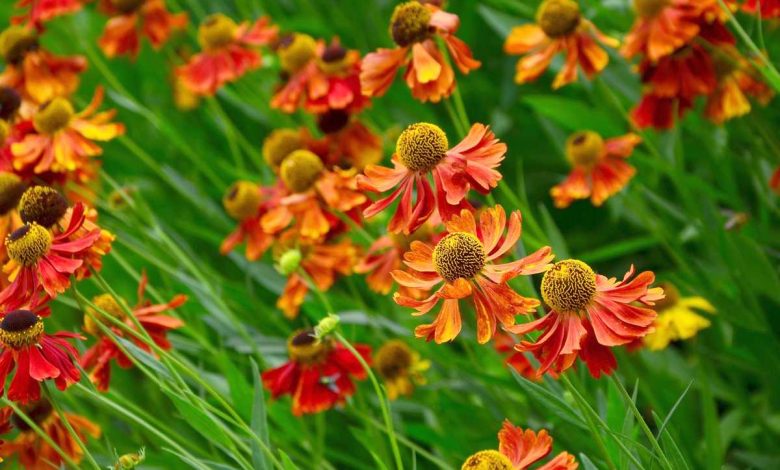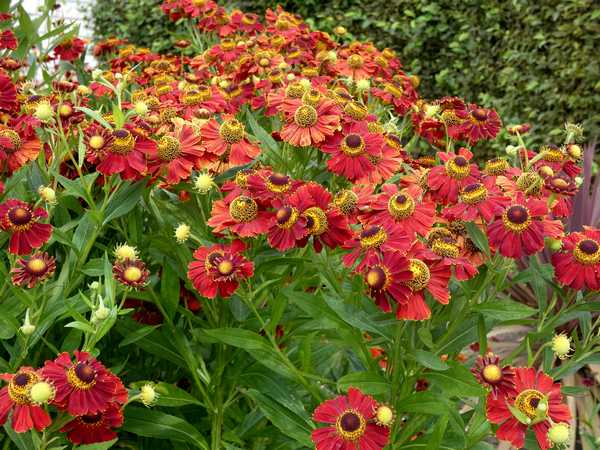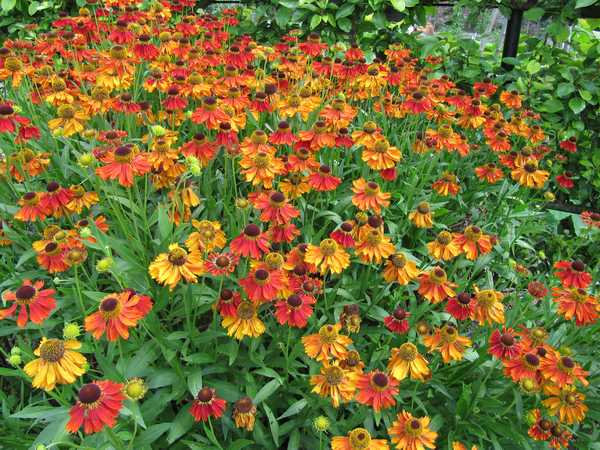
Native to North America, the helenia is a perennial cousin of the daisy, sunflowers, echinacea, gaillardia, or even rudbeckia which is covered towards the end of summer with yellow flowers, orange- coppery or even red. Planted in groups, it animates flowerbeds all fall.
In summary :
Botanical name : Helenium automnale
Common name : Helenium , autumn helenia
Family : Asteraceae
Height : on average 1m for about 80 cm wide.
Flowers : From June for the earliest, until the first frosts. The heart forms a large velvety ball above a petticoat formed by the petals with warm hues: golden yellow, orange, copper, red
Exposure : full sun, hate shade
Soil : good light and fresh garden soil , even slightly calcareous
Hardiness : very good
Planting Helenium
It is best planted in early spring (from the beginning of March). Like all perennials:
- Leave the bucket to soak in water for about ten minutes.
- Unpot then loosen the roots with your fingers.
- Plant in the new bed: the soil must be worked, lightened if it is clayey and enriched with compost.
- Water immediately after planting, at the neck of the watering can.

Helena maintenance
Helenias are easy-going perennials :
- The essential point concerns watering : Heleniums hate prolonged drought. Regular watering is needed to keep the soil cool.
- These American perennials also like rich soil. Add a handful of compost on the surface, another handful of seaweed manure in the spring, when they start growing again. (March April)
- During the spring, do not hesitate to pinch the young shoots to create ramifications and keep a more compact habit.
- From August, regularly remove the faded flowers to cause a significant increase in flowering for the end of summer and autumn.
- Fold back the clump entirely when it dries: in autumn or at the very end of winter.
- Helenia, like many Asteraceae, is quite sensitive to downy mildew in September-October. Make one or two treatments with Bordeaux mixture to keep foliage healthy.
- More robust, modern varieties are more resistant to the weight of the flowers and the wind. Help them not to collapse by setting up discreet staking from the start of growth, especially if you live in a windy region or if the stems of your helenias are quite frail. In a perennial border, strong neighboring plants play this role.
- Wear gloves for maintenance: all parts of the plant are poisonous. Their contact causes allergic skin reactions in more sensitive people.
With which plants to associate them?
By their dazzling colors, the helenias are sufficient in themselves but they are even more beautiful in a set of tall perennials. They need voluminous companions just as colorful as they are: Crocosmias , kniphofias or Satan’s embers, daylilies or day lilies, or even Dahlias with single flowers.
Even if the association is possible with other Asteraceae (Rudbeckia, Echinacea, Helianthus), it is less obvious to obtain a harmonious result because of the similarities of their habit and their flowers.
The grasses, by their delicacy, also go very well with the pompoms of the helenias and accompany them until the twilight of autumn: plant Stipa gigantea, Panicum virgatum, Miscanthus sinensis…

Division of Helenia
The division makes it possible to multiply and regenerate the clumps after 2 to 3 years of cultivation so that they remain floriferous. It can be done at 2 times of the year:
- At the end of October, take shards using a large knife. Replant them immediately in another bed.
- But you can also wait until March or April. Then collect young shoots with roots. They resume without difficulty in a softened ground.
Remarkable varieties of Helenium
The current varieties are the result of numerous hybridizations carried out at the beginning of the 20th century. They are classified according to their colors:
- The Red Hélénies : Rubinzwerg, Rubinkuppel, Red army, Baudirektor Linne, Indian summer, Ruby Tuesday, Red jewel…
- Yellow Hélénies : Die blonde, The bishop, Tijuana Brass, Hartmut Rieger, Wersergold, Can-Can, Kanaria, Helena, Goldraussch…
- The orange/copper Hélénies : Windley, Feuersiegel, Sahin’s early flowerer, Tie Dye
Here are the 2 most beautiful (classic) that give many flowers to bouquets:
Hélénie Moerheim beauty
Obtained in 1930, despite the passing of time, it remains one of the most beautiful Hellenes. Its coppery red flowers bloom from June until autumn. The bees love it. Then the granivorous birds visit it if the flowering stems are not pruned in the fall.
Once the petals have dried, the heart remains, forming a graphic ball giving a great look to dry bouquets.
Height: 80 cm to 1.20 m.
Hélénie Fire Seal
Created in 1959 by the German Foerster, the yellow petals of this helenia are marked with an elegant orange-red band. For its qualities, this variety was rewarded by the English Royal Society of Horticulture.
